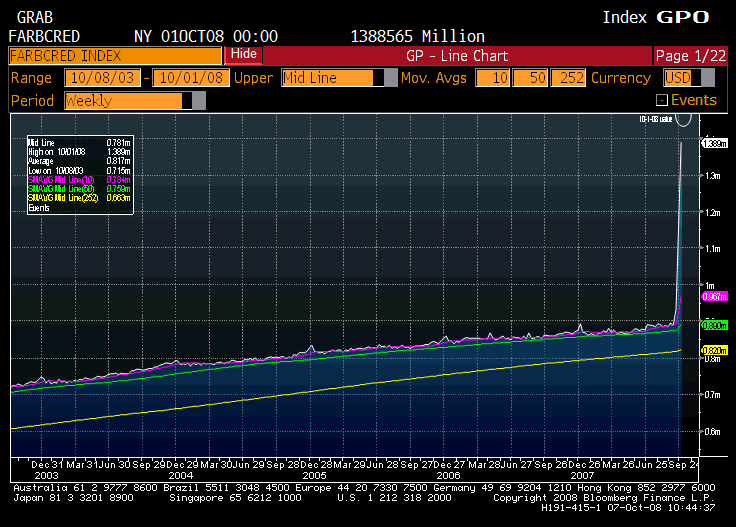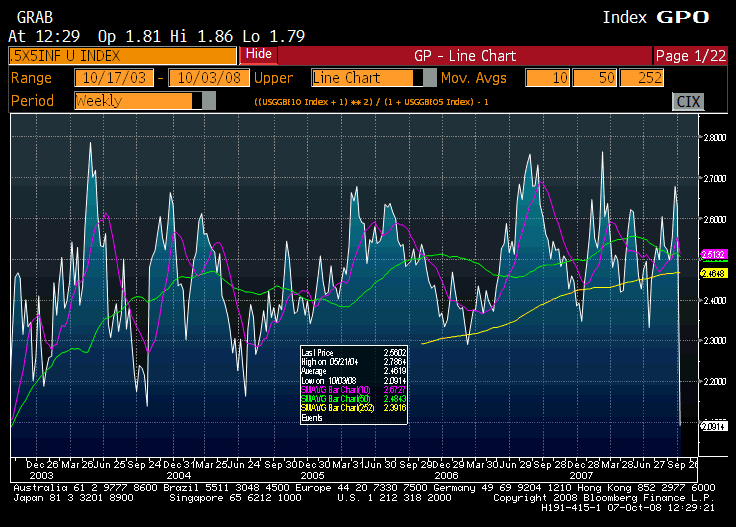These are the times that try my soul as a portfolio manager.? During crises, I am forced to make tradeoffs of the short-, intermediate-, and long-terms.
- Short-term: technical oversold/overbought-ness.
- Intermediate-term: valuation levels.
- Long-term: what industries benefit from economic change?
This is a difficult balancing act.? What makes matters more complex here is trying to understand what impact the actions of the Fed/Treasury are likely to have on the Dollar.? I hope to have another post up on the balance sheet of the Fed, for now, here’s the graph that Ron Smith called “the hockey stick.”
As I note in the graph above, the changes are even larger than the change in the weekly average figures.? Now, this isn’t presently going to be inflationary, because the Fed is (sort of) acting as an agent for the US Treasury in bailing out lending markets.? The US Treasury creates T-bills or notes, gives them to the Fed, and the Fed uses them as collateral in their collateralized lending programs.
The difficulty comes here: it’s easy to create these programs, but hard to shut them down.? Now the Fed will buy commercial paper.? Talk about unbacked paper money, CP is unsecured by any assets of the company receiving the loan.? jck at Alea rightly calls this not-so-wee beastie the Super-SIV.? As I commented there:
The question is: what are the endgames for these programs… TAF, CPFF. PDCF, TSLF, TARP, the bailouts of Bear and AIG, etc?? Once a market gets a taste of cheap credit, it is difficult to get them to give it up; they begin to depend on it.
And there are more demands for use of the credit of the US Government.? Bill Gross wants Fed funds at 1%, and wants the Fed to guarantee that institutional transactions clear.? Sounds simple, but the devil is in the details.? The essentially means that the Fed takes short term risk of financial firms failing while securities are in the course of settlement.? The losses could be significant in a crisis, but so could the calming effect.
The Treasury/Fed hopes that if they can calm the markets, eliminating fear of cascading defaults, eventually the markets will regain a tolerance for risk, and they can slowly eliminate the new lending programs.? My sense is that is the Japanese solution, and we are still waiting after two decades to see if it works.? Other “solutions” include:
- Inflating away the value of the promises made. (I.e., monetizing some of the T-securities that have been printed and given to the Fed.)
- Increasing taxation to pay for the credit losses from the bailouts.
- Creating a two-tier currency system, where foreign lenders get paid back in a cheaper currency, but domestic lenders don’t get so badly affected.
- Or, a combination of the above four.? Like jazz, I think policymakers are making it up as they go along, and will use a wide variety of solutions.
And, all of this hinges on the willingness of those who buy Treasury and Agency securities to continue to do so.? On the bright side, the disarray in Europe is making the US Dollar and Japanese Yen more attractive, giving the US the opportunity to issue more debt at a time when it will be needed for the TARP.
I come down on the side of an eventual inflation, monetizing the debts of the US Treasury, though that is a minority opinion at present.? It certainly isn’t showing in the TIPS market.? Take a look at one of Greenspan’s favorite graphs, five year inflation, five years forward:
After six years of stability in this statistic, expected inflation has gone over Niagra in a barrel.? Call me a nut, but I like TIPS even more here.? Very cheap inflation insurance, which I think we will need when this comes into its endgame.
Most of the pressure is toward a lower Fed funds target rate, but given that the Fed has sterilized their prior cuts, I don’t see what great good it will do.? It just gets us closer to the zero bound, after which, Japanese quantitative easing exists, and the infamous helicopters of Friedman and Bernanke.? As it stands now, I don’t put much credibility in a Fed funds rate cut.? The Fed seems committed to using its balance sheet to intervene in lending markets, not the more traditional stimulus of the economy as done in the past.
Truth, I am not sure where this ends, but from my recent discussions with Ron Smith and Dr. Jeff Miller, the solutions aren’t easy or pretty.? The time to have acted was 5-15 years ago, and we don’t have a wayback machine.



October 7th, 2008 at 9:58 am I think you pegged it calling it the Super-SIV. As I commented in late 2007 as the Fed began this series of interventions in lending markets, it is easier to start these actions than to complete them. It is hard to estimate all of the consequences.Just as I think George Bush, Jr., started to go wrong when he concluded that he had found his mission (fight terrorism, without boundaries), Ben Bernanke faces a similar problem (do whatever it takes to stop the Second Great Depression, without boundaries).
History is being made here, and it will be volatile?
And jck responded:
October 7th, 2008 at 10:14 am one thing we know for sure, is that the policy of ?promoting? liquidity appears to have backfired, no reasonable person would claim that markets are functioning better now than when they started?in fact some people would say they are a lot worse.
as you say David, very hard to get out of this, I don?t expect to see a normal Fed balance sheet, i.e treasuries_t-bills in my lifetime.
I will pop in for a comment on your euro piece a bit later?busy???